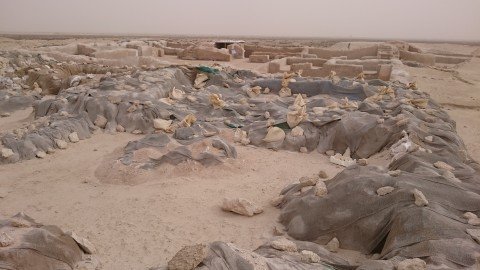Focus on Qatar: not only sumptuous museums, at Al Zubarah also serious archaeology
- Al Zubarah Fort, 1938, Qatar.
- Al Zubarah Fort, 1938, Qatar.
- Al Zubarah, Archeological site, Qatar. UNESCO world heritage site since 2013.
- Al Zubarah, Archeological site, Qatar. UNESCO world heritage site since 2013.
- Al Zubarah, Archeological site, Qatar. UNESCO world heritage site since 2013.
- Al Zubarah, Archeological site, Qatar. UNESCO world heritage site since 2013.
- Al Zubarah, Archeological site, Qatar. UNESCO world heritage site since 2013.
Located on the north-western coast of Qatar, about 100km from its capital Doha, Al Zubarah Archeological Site is a fine example of an 18th-19th century pearl fishing and trading town. In 2013 the site was included into the UNESCO World Heritage List, thus becoming Qatar’s first UNESCO Heritage site.
The town was founded by merchants from Kuwait. It reached its prosperity in the 1760s and was partially destroyed in 1811. A smaller settlement was built in the second half of the 19th century but it was finally abandoned in the early 20th century. The property comprises the remains of the town, the harbour and double defensive walls, a canal, two screening walls, and cemeteries as well as the remains of the fort of Qal’at Murair.
If you come from Doha however, you will first encounter the Zurbarah Fort, a military fortress which was built by H.H. Sheikh Abdullah bin Qassim in 1938 to serve as a Coast Guard station. The Fort has now been turned into a museum, and it is indeed the starting point where the visitor can get acquainted with the history of the fisherman town of Al Zubarah as well as with the archaeological works that the site is undergoing. Information panels, digital displays, explanation videos are only some of the many resources that the center, located in the middle of the desert, offers to the visitor as medium to shed some lights on the “only remaining complete urban plan of an Arabian pearl-merchant town”, as stated on the UNESCO website.
It is a matter of fact that the desert can be a double-edge sword when it comes to archaeological ruins. On the one hand, the sand blown from the desert has covered, thus protected the site for many years; on the other however, the desert harsh climate embodies a real problem for the conservation of the fragile remains revealed up to now. Since the first excavation project in the early 1980s up until 2003, the ruins have been badly managed and this lack of maintenance resulted in a decay of the exposed walls. This may be indeed one of the reasons that led the Qatar Museum Authority, together with the University of Copenhagen, to launch the Qatar Islamic Archaeology and Heritage Project (QIAH) in 2009. Since then, a international team of experts has been working to investigate the area and its hinterland, to preserve the site and to present it to the public, amongst other objectives. This ten-year research program will end in 2019, when the full management of the site will be entrusted solely to the QMA.
Thanks to this project, the visitor is able to walk behind the walls of a fortified town, that is unique in the way it represents an exceptional example of a coastal trading society and of its interaction with the surrounding desert environment. At the same time the remains, including pearl divers’ weights, imported ceramics, fish traps, now preserved in the Al Zubarah Fort, allow the visitor, together with the wide information resources available, to experience the merchant and pearl tradition of one the many prosperous centers that flourished in the Gulf region during the 18th and 19th centuries.
November 25, 2020







